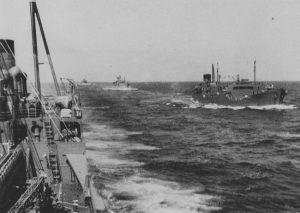How did a relatively poor (by the standards of the United States) nation manage to coordinate offensive naval operations across an extraordinarily wide front in the first six months of 1942? The answer has rarely focused on logistics. In fact, historians have long argued that one of the key U.S. advantages during the war was innovation in the field of underway replenishment. This advantage, especially in the later years of the war, enabled the U.S. Navy to undertake the grand offensives of the island-hopping campaign of 1944.
But maybe that’s not right, or at least it’s not all of the story. In a forthcoming article in the Journal of Military History, David Fuquea argues that the Imperial Japanese Navy had identified underway replenishment as a need as early as the 1920s, and that it had well honed its support capabilities by the beginning of the war. Fuquea establishes both the tactical difficulties associated with underway replenishment, a task that requires tight coordination between two ships transferring flammable material at high speed, and the long-standing historiographical view of Japanese logistics.
The Japanese appreciated the connection between their strategic need for oil and the operational need to keep the fleet fueled. They identified the requirement for fast tankers, and the doctrine and training necessary to use them, as early as 1926. Japan identified a need for fast tankers in the 1930s and subsidized construction of such ships throughout the decade. These tankers required military-grade construction, as conventional commercial ships were neither fast nor robust enough to serve with the fleet. Extensive training and practice came in the months before the Pearl Harbor attack, with many of the finest officers assigned to the oilers needed to keep the aircraft carriers, battleships, and cruisers in service. This work built upon training and doctrine developed in the years before the war.
By the start of the war, the Japanese held a near-monopoly on fast tankers around the world. Several of these ships accompanied the Pearl Harbor strike force, and then supported the Indian Ocean raid and the other Imperial Japanese Navy offensives. All of this placed the Imperial Japanese Navy well ahead of the U.S. Navy, both in ships and in training. Doctrine for underway replenishment in the U.S. Navy mostly came after the beginning of the war, and the Pacific Fleet felt an acute shortage of military-capable oilers in the first years of the war.
The Japanese fast oiler fleet suffered the same fate as every other part of the Japanese merchant marine; destruction by the torpedoes of American submarines. During the great battles of 1944, the Imperial Japanese Navy could no longer rely on its support fleet, which was badly attrited by the U.S. submarine campaign. And by this time the Americans had caught up to where the Japanese were in 1942, enabling the U.S. Navy to fight and win on the far side of the Pacific. Nevertheless, a better understanding of the evolution of logistical training and preparation in the Imperial Japanese Navy offers a fuller picture of the foundations of naval power in the 20th century.

































